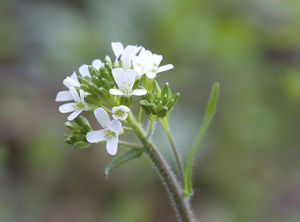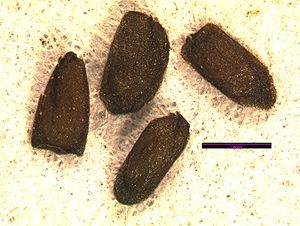Difference between revisions of "Arabis eschscholtziana"
m (→References) (Tag: VisualEditor) |
(→Description) (Tag: VisualEditor) |
||
| Line 23: | Line 23: | ||
}} | }} | ||
== Description == | == Description == | ||
| − | General: Biennial from a simple crown and strong taproot, the 1-several simple stems 1.5-10 dm. tall, pubescent at the base with stiff, simple hairs, becoming glabrous above. | + | General: Biennial from a simple crown and strong taproot, the 1-several simple stems 1.5-10 dm. tall, pubescent at the base with stiff, simple hairs, becoming glabrous above.<ref name=":0">WTU Herbarium, Burke Museum, & University of Washington. Retrieved from<nowiki/>http://biology.burke.washington.edu/herbarium/imagecollection/taxon.php?Taxon=Arabis%20eschscholtziana</ref> |
| − | Leaves: Leaves mainly cauline, the basal oblanceolate, 2-8 cm. long, narrowed to short, winged petioles, mostly glabrous on the upper surface, the lower surface purplish, pubescent with stiff, simple hairs; cauline leaves alternate, 5-15, remote to overlapping, sessile and auriculate, ovate-lanceolate to narrowly lance-elliptic, 2-12 cm. long and up to 3 cm. broad, pubescent as the basal leaves or the upper glabrous. | + | Leaves: Leaves mainly cauline, the basal oblanceolate, 2-8 cm. long, narrowed to short, winged petioles, mostly glabrous on the upper surface, the lower surface purplish, pubescent with stiff, simple hairs; cauline leaves alternate, 5-15, remote to overlapping, sessile and auriculate, ovate-lanceolate to narrowly lance-elliptic, 2-12 cm. long and up to 3 cm. broad, pubescent as the basal leaves or the upper glabrous.<ref name=":0" /> |
Flowers: Inflorescence of many-flowered, simple to compound racemes; pedicels 6-9 mm. long; sepals 4, 3-5 mm. long, glabrous, the outer 2 gibbous-based; petals 4, white to cream or pinkish, 4-9 mm. long; stamens 6; style 0.5-1 mm. long. | Flowers: Inflorescence of many-flowered, simple to compound racemes; pedicels 6-9 mm. long; sepals 4, 3-5 mm. long, glabrous, the outer 2 gibbous-based; petals 4, white to cream or pinkish, 4-9 mm. long; stamens 6; style 0.5-1 mm. long. | ||
| − | Fruit: Siliques glabrous, 3-8 cm. long and 1-2 mm. broad, 1-nerved, strictly erect; seeds in 1 series, 1.5-2 mm. long, wingless or with a wing up to 0.3 mm. broad. | + | Fruit: Siliques glabrous, 3-8 cm. long and 1-2 mm. broad, 1-nerved, strictly erect; seeds in 1 series, 1.5-2 mm. long, wingless or with a wing up to 0.3 mm. broad.<ref name=":0" /> |
== Bloom Period == | == Bloom Period == | ||
| + | April to July<ref name=":0" /> | ||
| − | |||
| − | |||
| − | |||
| − | |||
| − | |||
== Distribution == | == Distribution == | ||
Circumpolar; in North America, south to California and New Mexico. | Circumpolar; in North America, south to California and New Mexico. | ||
== Habitat == | == Habitat == | ||
| − | Moist to dry, usually calcareous, open situations: open woods, stream banks, ledges, cliffs, bluffs, and floodplains. It occurs frequently in disturbed habitats. Dunes and dry banks, rocky/chalk, limestone slopes and gravelly native prairie. Plants seem to be more abundant where grazing is light. | + | Moist to dry, usually calcareous, open situations: open woods, stream banks, ledges, cliffs, bluffs, and floodplains. It occurs frequently in disturbed habitats. Dunes and dry banks, rocky/chalk, limestone slopes and gravelly native prairie. Plants seem to be more abundant where grazing is light.<ref>University of Washington. Retrieved from <nowiki>https://depts.washington.edu/propplnt/Plants/Arabis.htm</nowiki>.</ref> |
== Uses == | == Uses == | ||
== Propagation == | == Propagation == | ||
| − | Sow the seed as soon as it is ripe in a light position in a cold frame. Seed can also be sown in spring. When large enough to handle, prick the seedlings out into individual pots and plant them out in the summer. Conduct divisions after flowering, usually in the spring. The divisions can be planted into their permanent plots if required. | + | Sow the seed as soon as it is ripe in a light position in a cold frame. Seed can also be sown in spring. When large enough to handle, prick the seedlings out into individual pots and plant them out in the summer. Conduct divisions after flowering, usually in the spring. The divisions can be planted into their permanent plots if required. <ref>Rice, G. (1988). ''A Wide Range of Perennial Plants that can be Grown in Britian and How to Grow Them''. Volume 2. Thompson and Morgan.</ref> |
===Seed=== | ===Seed=== | ||
Revision as of 13:16, 12 March 2021
- Latin Name: Arabis eschscholtziana
- Family: Brassicaceae
- Common Names: hairy rockcress, Pacific coast rockcress
- Synonyms/Misapplications: Arabis hirsuta var. eschscholtziana, Arabis hirsuta var. glabrata
- Codon: ARAHIR
| Arabis eschscholtziana | |
|---|---|

| |
| Photo by Rod Gilbert. Also featured on Main Page | |
| Scientific classification | |
| Kingdom: | Plantae |
| Subkingdom: | Tracheobionta |
| Phylum: | Spermatophyta |
| Subphylum: | Magnoliophyta |
| Class: | Magnoliopsida |
| Subclass: | Rosanae |
| Order: | Brassicales |
| Family: | Brassicaceae |
| Genus: | Arabis L. |
| Species: | Arabis escholtziana Andrz. |
Contents
Description
General: Biennial from a simple crown and strong taproot, the 1-several simple stems 1.5-10 dm. tall, pubescent at the base with stiff, simple hairs, becoming glabrous above.[1]
Leaves: Leaves mainly cauline, the basal oblanceolate, 2-8 cm. long, narrowed to short, winged petioles, mostly glabrous on the upper surface, the lower surface purplish, pubescent with stiff, simple hairs; cauline leaves alternate, 5-15, remote to overlapping, sessile and auriculate, ovate-lanceolate to narrowly lance-elliptic, 2-12 cm. long and up to 3 cm. broad, pubescent as the basal leaves or the upper glabrous.[1]
Flowers: Inflorescence of many-flowered, simple to compound racemes; pedicels 6-9 mm. long; sepals 4, 3-5 mm. long, glabrous, the outer 2 gibbous-based; petals 4, white to cream or pinkish, 4-9 mm. long; stamens 6; style 0.5-1 mm. long. Fruit: Siliques glabrous, 3-8 cm. long and 1-2 mm. broad, 1-nerved, strictly erect; seeds in 1 series, 1.5-2 mm. long, wingless or with a wing up to 0.3 mm. broad.[1]
Bloom Period
April to July[1]
Distribution
Circumpolar; in North America, south to California and New Mexico.
Habitat
Moist to dry, usually calcareous, open situations: open woods, stream banks, ledges, cliffs, bluffs, and floodplains. It occurs frequently in disturbed habitats. Dunes and dry banks, rocky/chalk, limestone slopes and gravelly native prairie. Plants seem to be more abundant where grazing is light.[2]
Uses
Propagation
Sow the seed as soon as it is ripe in a light position in a cold frame. Seed can also be sown in spring. When large enough to handle, prick the seedlings out into individual pots and plant them out in the summer. Conduct divisions after flowering, usually in the spring. The divisions can be planted into their permanent plots if required. [3]
Seed
Seed sample from: 2011
Average Measurement: 1.6 x 0.9 x 0.2
Measurement Range: L: 1.3 - 1.75, W: 0.6 - 1, D: 0.1 - 0.3
Features
Shape: Seeds flat, somewhat winged, especially at hilum end and opposite. Accumbent cotyledons and sulcus present.
Color: Seed dark brown in center, darkening to black at the winged edges. Hilum inconspicuous.
Surface: Texture is bumpy, and seed is somewhat lustrous.
Latitudinal Cross Section: elliptical ![]()
Longitudinal Cross Section: elliptical ![]()
Basic Explanations and Assumptions:
The dimensions for the seeds are length x width x depth. The location of the hilum is used as the base of the seed, and the length is measured from hilum to the opposite apex. Where a style is present, the length is measured from the hilum to the bottom of the style. Width is measured at a right angle to the length at the widest part. Depth is measured at a right angle to the intersection of height and width lines.
Measurements included are the mean average for each measurement of ten separate seeds.
All measurements in millimeters unless otherwise noted.
Photo Gallery
References
- ↑ 1.0 1.1 1.2 1.3 WTU Herbarium, Burke Museum, & University of Washington. Retrieved fromhttp://biology.burke.washington.edu/herbarium/imagecollection/taxon.php?Taxon=Arabis%20eschscholtziana
- ↑ University of Washington. Retrieved from https://depts.washington.edu/propplnt/Plants/Arabis.htm.
- ↑ Rice, G. (1988). A Wide Range of Perennial Plants that can be Grown in Britian and How to Grow Them. Volume 2. Thompson and Morgan.


